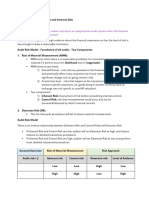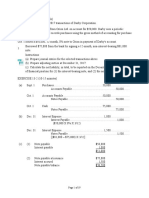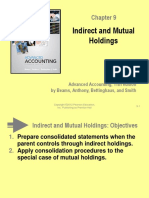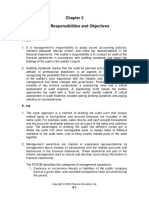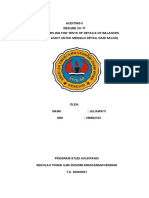Case Study 2-Week 10: Discuss
Uploaded by
MIMIS SASMIATICase Study 2-Week 10: Discuss
Uploaded by
MIMIS SASMIATICase study 2- Week 10
Following are audit procedures commonly performed in the inventory and warehousing cycle for a
manufacturing company:
1. Compare the client’s count of physical inventory at an interim date with the perpetual
inventory master file.
2. Trace the auditor’s test counts recorded in the working papers to the final inventory
compilation and compare tag number, description and quantity.
3. Compare the unit price on the final inventory summary with vendor’s invoices.
4. Read the client’s physical inventory instructions and observe whether they are being
followed by those responsible for counting the inventory.
5. Account for sequence of raw materials requisitions and examine each requisition for an
authorized approval.
6. Trace the recorded additions on the finished goods perpetual inventory master file to the
records for completed productions.
7. Account for a sequence of inventory tags, and trace each tag to the physical inventory to
make sure it actual exists.
Discuss:
1. Identify whether each procedure is primarily a test of control or a substantive test.
2. State the purpose (s) of each procedure.
AUDIT a. b.
PROCEDURE TYPE OF TEST PURPOSE
1 Substantive test of To test accuracy of the client’s perpetual
transactions inventory records. (Occurrence,
Completeness and Accuracy)
2 Substantive test of To test client’s final inventory compilation.
transactions (Occurrence, Completeness, Accuracy and
Classification)
3 Substantive test of To test that final inventory was valued at
transactions its proper cost. (Accuracy)
4 Test of control To ensure that proper controls exist and
are being followed in the taking of the
physical inventory. (Occurrence,
Completeness, Accuracy and
Classification)
5 Test of control To ensure that no raw material was issued
without proper approval. (Occurrence)
6 Test of control or To ensure that additions recorded on the
Substantive test of finished goods perpetual records were
transactions recorded on the books as completed
production. (Accuracy and Classification)
7 Substantive test of To ensure that all inventory represented
transactions by an inventory tag actually exists.
(Occurrence)
Case study 3- Week 10
TechParts Ltd is a retailer of computer hardware components. The company buys inventory
items in bulk directly from manufacturers and sells the parts to computer and other
technology equipment manufacturers that use them as components in their products.
TechParts grants suppliers access to its inventory management system through its internet
website. Suppliers have real-time access to information about the parts inventory, including
information about quantities held, storage locations and forecast product demand. In
addition, customers have online access through the website to information on product
description, price, delivery estimates, availability status, and quality and reliability ratings.
Customers can also access information to assess the compatibility of selected parts with other
components used in their production process.
Discuss:
1. Identify business objectives that TechParts’ management may able to achieve by
providing this information online to key suppliers and customers.
2. How might the availability of the information to suppliers and customers increase
TechParts’ business risk
3. What process should TechParts’ management implement to minimise business risk?
4. How might the availability of the information increase the risk of material
misstatements in the financial reports?
a. TechnoParts Ltd may be seeking to achieve several business
objectives by providing inventory product information online through
the company’s website. The following are examples of possible
business objectives:
1. Reduced inventory management costs: By providing suppliers access to
inventory information, TechnoParts Ltd may be able to reduce costs
associated with inventory management by reducing the amount of time
inventory products are held in their warehouse. Suppliers have increased
information to time the delivery of products when most likely needed.
2. Increased sales to existing customers: Greater access to product
information may increase customer loyalty to TechnoParts. Increased
information that can be used by customers for their internal inventory
decision making may increase purchasing from TechnoParts.
3. Increased sales to new customers: By providing information about
products online, other customers not familiar with TechnoParts Ltd may
begin purchasing products through the company website. Providing
inventory product information, particularly quality and reliability ratings,
may make it easier for customers in remote geographic locations to
purchase products directly from TechnoParts.
4. Strengthen marketplace perceptions: Because TechnoParts is a supplier
in the technology industry, they may be using their Internet presence to
strengthen market perceptions that the company is embracing emerging
technologies, including the e-commerce method of transacting business.
• Providing online access to extensive inventory information may increase
TechnoParts’ business risks. For example:
1. Competitive information is released: The inclusion of detailed
information about inventory products, including information about
quantities on hand, forecasted demand, storage locations, quality and
reliability ratings may result in the release of information that
strategically benefits TechnoParts competitors. Not only will company
customers be able to access information, competitors may also be able
to access information. In addition, negotiations with existing suppliers
and customers may be negatively affected by the release of strategic
information.
2. Insufficient capacity to handle demand: If demand for products through
the website exceeds expectations, internal systems and personnel may
not be able to handle the volume of orders in a timely fashion. The time
it takes for inventory warehousing and distribution processes for online
sales may be greater than expected given that single orders must be
individually handled. In contrast, shipments made to retail outlets are
often processed in bulk.
3. Inadequate accounting system interface: The offering of sales online
requires the design and implementation of new Internet-based
accounting systems that must capture, process and record online
transactions. Those transactions must be integrated with traditional
sales transactions into the company’s accounting records and financial
statements. Those systems may not be adequately designed for timely
and accurate interface.
4. Inaccurate information: Because of the volume of information being
presented about each product, there is some risk that the information
presented is not accurate or up-to-date. Additionally, the amount of
information needed by customers is likely to vary extensively. Thus,
there is some risk that needed information is not disclosed. This may
discourage suppliers and customers from doing business with
TechnoParts.
5. Supplier and customer privacy: If suppliers and customers transact with
TechnoParts through the website, there is some risk that confidential
information may be obtained during the transmission process. Breaches
in supplier and customer privacy may affect future demand and may
increase legal exposure for TechnoParts.
6. Security: TechnoParts may be exposing its inventory records and related
IT systems to security breaches. Outsiders will be accessing the
company website and related inventory databases that interface with
existing internal systems. Unintentional and intentional errors may be
introduced.
• Procedures may be implemented to minimise each of the business risks
identified in part b:
1. Competitive information is released: To protect the release of sensitive
information, TechnoParts may consider restricting website access through the
use of passwords issued to approved suppliers and customers.
2. Insufficient capacity to handle demand: The company should closely monitor
existing systems and personnel needs on a daily basis to ensure that processing
demand can be satisfied with the existing system. Testing of the system should
occur before implementation. Business contingency plans should address how
the company can handle sharp increases in processing demand.
3. Inadequate accounting system interface: Systems should be designed, tested
and implemented to ensure that purchases or sales made via the online system
are automatically captured in the company accounting records.
4. Inaccurate information: Timely updates to the information made available on
the website should occur regularly. The company should seek extensive
information about product descriptions from its suppliers and encourage
feedback from customers about product quality. Access to the databases
containing the product information should be restricted to authorised personnel.
5. Supplier and customer privacy: Policies should be established to restrict the
release of sensitive supplier and customer information. The use of encryption
techniques would increase the protection of sensitive information during
transmission.
6. Security: Adequate protection, such as firewalls and user passwords, are
needed to protect company systems from infiltration.
d. The availability of inventory information on TechnoParts’ website may
increase the risk of material misstatements in several ways:
1. Competitive information is released: If the release of strategic
information negatively affects company negotiations with suppliers and
customers, inventory costs may increase and sales may decrease. If
those changes occur, there may be increased pressure for management
to generate profits, which may increase the likelihood of material
misstatements due to fraud.
2. Insufficient capacity to handle demand: If demand for products through
the TechnoParts website exceeds the company’s ability to process orders
in a timely fashion, consumers may cancel earlier recorded orders or
request returns when delivery occurs well beyond the expected delivery
date. The accounting systems must be designed to accurately reflect
cancellations and returns in a timely fashion consistent with accounting
principles. Additionally, if the processing of orders is significantly
delayed, the accounting systems must be adequately designed to ensure
sales are not recorded prematurely (e.g. not until delivery).
3. Inadequate accounting system interface: If the online sales or inventory
purchasing system interface with the main accounting system is
inadequate, online transactions may (1) not be processed, (2) be
processed more than once, or (3) be processed inaccurately. Any of
these risks could lead to material misstatements in the financial
statements.
4. Inaccurate information: If inaccurate information posted online is used
to process inventory transactions, the transactions may be inaccurately
processed and recorded in the accounting records, resulting in material
misstatements.
5. Consumer privacy: If consumer privacy is breached, existing sales may
be cancelled or returns beyond the normal period may be requested.
Such activity would need to be properly reflected in the financial
statements. Additionally, legal exposures may increase, which may
require additional financial statement disclosures.
6. Security: Unauthorised access to the TechnoParts inventory database or
other IT system records may introduce unintentional and intentional
misstatements into the accounting records. If unauthorised access is not
restricted, material misstatements in financial statements may result.
You might also like
- Paul Elliott (Editor) - Julie Storr (Editor) - Annette Jeanes (Editor) - Infection Prevention and Control - Perceptions and Perspectives-CRC Press (2016)0% (1)Paul Elliott (Editor) - Julie Storr (Editor) - Annette Jeanes (Editor) - Infection Prevention and Control - Perceptions and Perspectives-CRC Press (2016)235 pages
- BSBMKG435 Task 3 Assessment Instructions V2.0923No ratings yetBSBMKG435 Task 3 Assessment Instructions V2.09238 pages
- Ananta Faturrahman P.H. - Audit Forensik - PPT Case Week 5No ratings yetAnanta Faturrahman P.H. - Audit Forensik - PPT Case Week 510 pages
- 3-27 (Objectives 3-1, 3-2, 3-4, 3-6, 3-7)No ratings yet3-27 (Objectives 3-1, 3-2, 3-4, 3-6, 3-7)7 pages
- Universitas Pakuan: Fakultas Ekonomi Dan BisnisNo ratings yetUniversitas Pakuan: Fakultas Ekonomi Dan Bisnis2 pages
- Nama: Nurahma Amalia NIM: 20200070042 Kelas: AK20ANo ratings yetNama: Nurahma Amalia NIM: 20200070042 Kelas: AK20A4 pages
- Accy225 Tri 2 2019 Tutorial 3 Revenue and Expenditure Controls SolutionNo ratings yetAccy225 Tri 2 2019 Tutorial 3 Revenue and Expenditure Controls Solution7 pages
- Foreword: Financial Auditing 1 - 9 Edition - 1No ratings yetForeword: Financial Auditing 1 - 9 Edition - 137 pages
- Acg5205 Solutions Ch.15 - Christensen 12eNo ratings yetAcg5205 Solutions Ch.15 - Christensen 12e19 pages
- Tugas PT3 Audit - Nanda Rizki Nugraha - 41801042No ratings yetTugas PT3 Audit - Nanda Rizki Nugraha - 418010426 pages
- Beams11 - Ppt09-Indirect Dan Mutual Holding For StudentNo ratings yetBeams11 - Ppt09-Indirect Dan Mutual Holding For Student44 pages
- Chapter 5: Intercompany Profit Transactions - InventoriesNo ratings yetChapter 5: Intercompany Profit Transactions - Inventories38 pages
- Auditing Gray 2015 Chapter 7 Systems Work Basic Ideas 1No ratings yetAuditing Gray 2015 Chapter 7 Systems Work Basic Ideas 137 pages
- Tusming 4 Audit Rivialdo Kazhadiva 023002000012No ratings yetTusming 4 Audit Rivialdo Kazhadiva 0230020000123 pages
- Kelompok 6 - Pengantar Praktik Pengauditan - Week 10No ratings yetKelompok 6 - Pengantar Praktik Pengauditan - Week 107 pages
- Solution CH 5 Audit Evidence and DocumentationNo ratings yetSolution CH 5 Audit Evidence and Documentation28 pages
- Business Combinations: Answers To Questions 1No ratings yetBusiness Combinations: Answers To Questions 114 pages
- Tugas Sesi 12 - Advance Accounting - Clement JonathanNo ratings yetTugas Sesi 12 - Advance Accounting - Clement Jonathan11 pages
- E18-16 (LO3) Sales With Returns: InstructionsNo ratings yetE18-16 (LO3) Sales With Returns: Instructions15 pages
- AKL 2 - Tugas 4 Marselinus A H T (A31113316)No ratings yetAKL 2 - Tugas 4 Marselinus A H T (A31113316)5 pages
- Resumen Chapter 19 - Intermediate AccountingNo ratings yetResumen Chapter 19 - Intermediate Accounting7 pages
- Auditing Ii Resume CH 17 Audit Sampling For Tests of Details of Balances (Contoh Audit Untuk Menguji Detail Dari Saldo)No ratings yetAuditing Ii Resume CH 17 Audit Sampling For Tests of Details of Balances (Contoh Audit Untuk Menguji Detail Dari Saldo)22 pages
- Stock Investments - Investor Accounting & ReportingNo ratings yetStock Investments - Investor Accounting & Reporting46 pages
- Allocation and Depreciation of Differences Between Implied and Book Values AcquisitionNo ratings yetAllocation and Depreciation of Differences Between Implied and Book Values Acquisition46 pages
- Case Study On Supply Chain Management at HP100% (2)Case Study On Supply Chain Management at HP11 pages
- fpx5016_mcneilchesley_assessment1-1 (1)No ratings yetfpx5016_mcneilchesley_assessment1-1 (1)10 pages
- Capital Budgeting - Discounted and Undiscounted MethodNo ratings yetCapital Budgeting - Discounted and Undiscounted Method47 pages
- Comparison Table ICH Q7 vs. FDA Q7 GuidelinesNo ratings yetComparison Table ICH Q7 vs. FDA Q7 Guidelines3 pages
- Instant download Marketing 2016 18th Edition William M. Pride pdf all chapter100% (21)Instant download Marketing 2016 18th Edition William M. Pride pdf all chapter60 pages
- Financial Accounting: Key Differences Between Management Accounting (MA) and Financial Accounting (FA)No ratings yetFinancial Accounting: Key Differences Between Management Accounting (MA) and Financial Accounting (FA)3 pages
- K To 12 Curriculum and Assessment Updates - Mam Edna Dumaog Topic PDFNo ratings yetK To 12 Curriculum and Assessment Updates - Mam Edna Dumaog Topic PDF63 pages
- Yudho Giri Sucahyo, PH.D, CISA, CISM, CEP-PM, CSRS: Faculty of Computer Science Universitas IndonesiaNo ratings yetYudho Giri Sucahyo, PH.D, CISA, CISM, CEP-PM, CSRS: Faculty of Computer Science Universitas Indonesia32 pages
- Andika Wahyu Perdana - 143231151 AKBI Tugas TM 6 (Fifo Method)No ratings yetAndika Wahyu Perdana - 143231151 AKBI Tugas TM 6 (Fifo Method)1 page
- Mindtree Brochures Murex Datamart Performance Optimization100% (2)Mindtree Brochures Murex Datamart Performance Optimization4 pages
- Safety Director EHS SH&E in Philadelphia PA Resume Dale JohnsonNo ratings yetSafety Director EHS SH&E in Philadelphia PA Resume Dale Johnson2 pages
- Re-Certification Audit of Iso 9001:2015: ST NDNo ratings yetRe-Certification Audit of Iso 9001:2015: ST ND4 pages
- Definitions of Organizational Behavior by Various AuthorsNo ratings yetDefinitions of Organizational Behavior by Various Authors11 pages
- Paul Elliott (Editor) - Julie Storr (Editor) - Annette Jeanes (Editor) - Infection Prevention and Control - Perceptions and Perspectives-CRC Press (2016)Paul Elliott (Editor) - Julie Storr (Editor) - Annette Jeanes (Editor) - Infection Prevention and Control - Perceptions and Perspectives-CRC Press (2016)
- Ananta Faturrahman P.H. - Audit Forensik - PPT Case Week 5Ananta Faturrahman P.H. - Audit Forensik - PPT Case Week 5
- Nama: Nurahma Amalia NIM: 20200070042 Kelas: AK20ANama: Nurahma Amalia NIM: 20200070042 Kelas: AK20A
- Accy225 Tri 2 2019 Tutorial 3 Revenue and Expenditure Controls SolutionAccy225 Tri 2 2019 Tutorial 3 Revenue and Expenditure Controls Solution
- Beams11 - Ppt09-Indirect Dan Mutual Holding For StudentBeams11 - Ppt09-Indirect Dan Mutual Holding For Student
- Chapter 5: Intercompany Profit Transactions - InventoriesChapter 5: Intercompany Profit Transactions - Inventories
- Auditing Gray 2015 Chapter 7 Systems Work Basic Ideas 1Auditing Gray 2015 Chapter 7 Systems Work Basic Ideas 1
- Kelompok 6 - Pengantar Praktik Pengauditan - Week 10Kelompok 6 - Pengantar Praktik Pengauditan - Week 10
- Tugas Sesi 12 - Advance Accounting - Clement JonathanTugas Sesi 12 - Advance Accounting - Clement Jonathan
- Auditing Ii Resume CH 17 Audit Sampling For Tests of Details of Balances (Contoh Audit Untuk Menguji Detail Dari Saldo)Auditing Ii Resume CH 17 Audit Sampling For Tests of Details of Balances (Contoh Audit Untuk Menguji Detail Dari Saldo)
- Stock Investments - Investor Accounting & ReportingStock Investments - Investor Accounting & Reporting
- Allocation and Depreciation of Differences Between Implied and Book Values AcquisitionAllocation and Depreciation of Differences Between Implied and Book Values Acquisition
- Capital Budgeting - Discounted and Undiscounted MethodCapital Budgeting - Discounted and Undiscounted Method
- Instant download Marketing 2016 18th Edition William M. Pride pdf all chapterInstant download Marketing 2016 18th Edition William M. Pride pdf all chapter
- Financial Accounting: Key Differences Between Management Accounting (MA) and Financial Accounting (FA)Financial Accounting: Key Differences Between Management Accounting (MA) and Financial Accounting (FA)
- K To 12 Curriculum and Assessment Updates - Mam Edna Dumaog Topic PDFK To 12 Curriculum and Assessment Updates - Mam Edna Dumaog Topic PDF
- Yudho Giri Sucahyo, PH.D, CISA, CISM, CEP-PM, CSRS: Faculty of Computer Science Universitas IndonesiaYudho Giri Sucahyo, PH.D, CISA, CISM, CEP-PM, CSRS: Faculty of Computer Science Universitas Indonesia
- Andika Wahyu Perdana - 143231151 AKBI Tugas TM 6 (Fifo Method)Andika Wahyu Perdana - 143231151 AKBI Tugas TM 6 (Fifo Method)
- Mindtree Brochures Murex Datamart Performance OptimizationMindtree Brochures Murex Datamart Performance Optimization
- Safety Director EHS SH&E in Philadelphia PA Resume Dale JohnsonSafety Director EHS SH&E in Philadelphia PA Resume Dale Johnson
- Definitions of Organizational Behavior by Various AuthorsDefinitions of Organizational Behavior by Various Authors




















